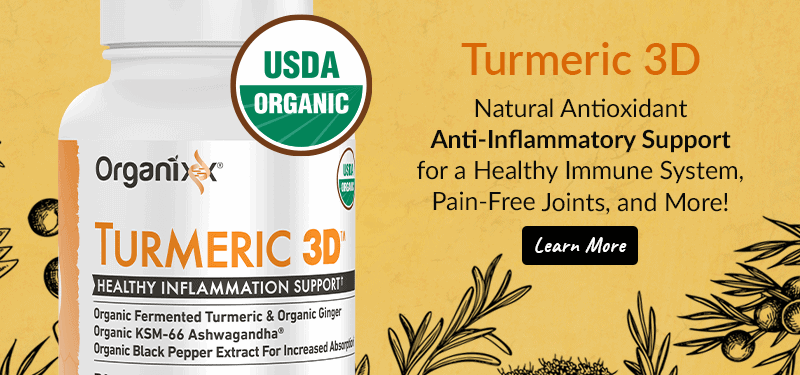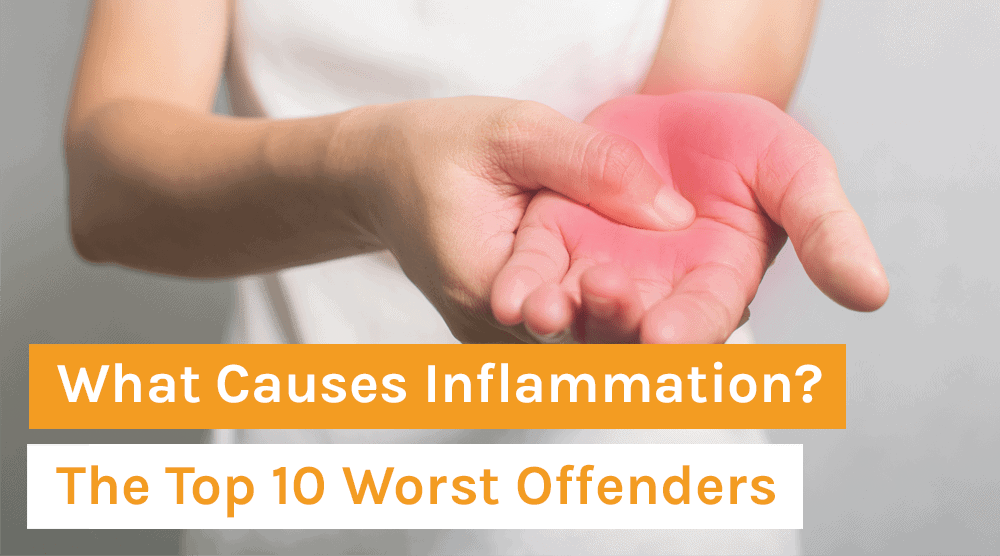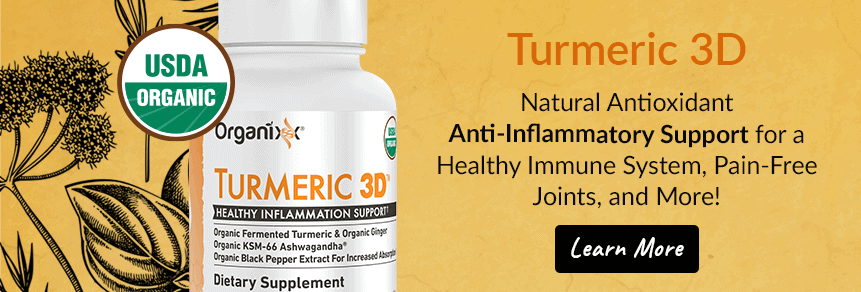What Causes Inflammation? The Top 10 Worst Offenders
In a hurry? Click here to read the Article Summary...
If you keep up with health news, you’re probably familiar with the buzzword inflammation and the ongoing discussion about the potentially harmful direct and side effects it can have on our health.
In fact, some health experts such as Dr. William Joel Meggs – an inflammation specialist at the Brody School of Medicine at East Carolina University and the author of the book The Inflammation Cure – even make the bold claim that inflammation ”may well turn out to be the elusive holy grail of medicine, the single phenomenon that holds the key to sickness and health.”
What Is Inflammation?
Before we try to understand why inflammation is so important and how it affects our health, let’s first consider the simple but very important question: what exactly is inflammation?
Simply put, inflammation is an important and necessary part of the healing process (i.e., our natural immune response). Its job is to protect our body against harm by:
- defending it against foreign invaders
- fighting off infections and illnesses
- repairing damaged cells and tissues in our body after injury
Normally, our immune system triggers inflammation when it recognizes anything that is alien in our body.
Such triggers can include invading bacteria or viruses, cigarette smoke, plant pollen, and the many thousands of synthetic chemicals we are exposed to during our lifetimes.
Inflammation Is the Body’s Response to Injury
We’ve all experienced inflammation when we develop a fever, bruise our knee, or cut our finger. For instance, our body reacts in a very predictable way when we twist an ankle:
- Blood flow to the affected area increases, which is why it typically turns red.
- Fluids and proteins from blood enter the injured tissues, which can cause localized swelling.
- Finally, our immune system sends a small army of white blood cells to the rescue. These typically include neutrophils, which are usually the first to travel to the site of an infection or injury. Neutrophils can literally swallow damaged cells and foreign invaders and also release enzymes that kill them.
Neutrophils may be accompanied by macrophages, another type of white blood cell that engulfs and “eats” anything not seen as healthy or normal.
In other words, short term or “acute” inflammation is a necessary, health-preserving component of our immune system’s response to injuries and infections. Without it, injuries could linger on and harm us, while even minor infections could turn deadly.
However, the key to the inflammatory process is that it is only meant to last a short time. Once our body has dealt with and gotten rid of the initial trigger or cause, the process of healing and repair should ideally begin.
What Is Chronic Inflammation?
Unfortunately, when our body’s inflammatory response goes on for too long or spirals out of control – known as chronic inflammation – it can lead to many adverse health conditions, according to health experts.
Chronic inflammation can happen when our immune system sometimes sends an inflammatory response to a perceived threat that doesn’t really exist.
At other times, the threat may be real but goes on for so long that our body’s inflammatory response also persists for a long time.
Persistent, uncontrolled inflammation – which has been linked to external factors we’ll discuss below – is damaging because it acts like a slow-burning fire, continuing to send out immune cells that eventually begin to attack healthy cells and tissues in our body.
According to Dr. Andrew Luster, of the Center for Immunology and Inflammatory Diseases at Harvard-affiliated Massachusetts General Hospital,
“It’s a smoldering process that injures your tissues, joints, and blood vessels, and you often do not notice it until significant damage is done.”
The Role of Free Radicals
Harmful free radicals, including reactive oxygen species (ROS), are believed to be the underlying cause of the damage to healthy cells caused by chronic inflammation.
Not only that, scientific research suggests that certain free radicals can directly initiate or even amplify inflammation by turning on several different genes that are involved in triggering and maintaining the inflammatory response.
These free radicals, including ROS, are likely created by the actions of the various immune cells that have been activated by the inflammatory process, specifically by the chemicals and enzymes they release into our body’s damaged tissues.
What is Chronic Inflammation Responsible for?
Chronic inflammation is now known to cause the buildup of plaque in arteries known as atherosclerosis. Our body sees such plaques as abnormal, so it tries to wall them off from flowing blood. But when that wall breaks down – and it eventually does – the plaque can rupture.
The plaque’s contents then mingle with blood, forming a clot that can block blood flow downstream where the blood vessel becomes narrower. These clots are responsible for most of the deadly heart-related health conditions (e.g., heart attack) that affect many people today.
Similarly, the more visceral fat cells we have – this is the kind of fat that builds up in the abdomen and wraps itself around organs – the more likely it is that our immune system sees them as a threat and triggers inflammation. As a result, more white blood cells enter our blood looking for a fight.
In other words, the longer we stay overweight or obese, the longer our body remains in a state of constant inflammation. According to Dr. Luster:
“This reaction is not confined to one particular place either. Inflammation can travel throughout the body and cause problems all over.”
Chronic inflammation is now believed to also contribute to the development of clinical depression and anxiety, generalized body pain, gut health disorders, and abnormal levels of tiredness or fatigue.
So, the question is: what triggers chronic inflammation and how can we manage these risks to reduce or even completely avoid our chances of developing an inflammatory condition?
What Causes Inflammation? Top 10 Offenders
Here are the top ten worst offenders believed to cause or contribute to chronic inflammation:

#1. Foods with a high glycemic index (GI) and added sugar
These include processed and refined foods such as white flour, instant mashed potatoes, and polished white rice, sweetened foods such as cakes, cookies, and muffins, and many commercially available breakfast cereals, breads, and pasta sauces.
The glycemic index (GI) is a ranking of carbohydrates on a scale from 0 to 100 according to the extent to which they raise our blood sugar levels after consumption. High GI foods are rapidly digested, absorbed, and metabolized by our body and cause significant fluctuations in our blood sugar levels.
Low GI carbs produce smaller fluctuations in our blood glucose and insulin levels; and according to many health experts, they represent one of the secrets to long-term health.
A 2002 study showed that processed sugars and high GI foods increase inflammation levels, leading to a greater risk of developing other health disorders. On the other hand, consumption of whole grains has been shown to reduce levels of the inflammation markers C-reactive protein and plasminogen activator inhibitor type 1.
High GI foods and excess dietary sugar likely trigger inflammation because they increase levels of chemical compounds in our body known as advanced glycation end products (AGEs), along with raising our risk of developing insulin resistance and harmful changes in lipid metabolism.
Scientific evidence shows that AGEs trigger inflammation in multiple ways. AGEs have also been shown to interfere with our body’s natural antioxidant defense systems and may even contribute to organ damage, compromising our health.
#2: Trans fats
A small amount of trans fats occurs naturally in certain animal foods. However, most of them are synthetically made in an industrial process that uses high pressure and chemicals to add hydrogen to liquid vegetable oils to make them more solid and have a longer shelf life.
The resulting end products, known as “partially hydrogenated oils,” are difficult for our body to process and end up triggering inflammation, at least partly by damaging cells in the lining of our blood vessels.
In 2013, the U.S. Food and Drug Administration (FDA) determined that partially hydrogenated oils are no longer Generally Recognized as Safe (GRAS) in human food. Indeed, consumption of trans fats in 823 generally healthy women in the Nurses’ Health Study I and II was seen to raise their levels of markers of systemic inflammation.
In other words, consumption of foods and food-related products containing trans fats should be completely avoided, as they have been shown to harm our health.
#3: Saturated animal fats
Consumption of saturated animal fats has been linked to a greater risk of developing inflammation-related health disorders in a number of studies. For instance, one study showed that the composition of our beneficial gut bacteria changes after eating saturated fats, particularly those from dairy found in many baked and processed foods.
The study authors stated that “as the balance of [microbiome] species shift, it can trigger an immune response that results in inflammation and tissue damage.”
It should be noted that many health experts who are in favor of high-fat diets point out that studies on saturated animal fats don’t take into account the quality of animal fats being consumed.
They believe that fats from pastured, grass-fed animals do not cause damage to the body as do saturated fats from conventionally-raised (factory-farmed) animals that are fed grains.
How meat is cooked is also a factor. Grilling protein foods such as meat and fish creates two kinds of pro-inflammatory chemical compounds – heterocyclic amines (HCAs) and polycyclic aromatic hydrocarbons (PAHs), which are also found in cigarette smoke. The charred bits at the edges of barbecued meat and fish are especially high in these toxic compounds. Cooking meats more slowly at lower temperatures is the best way to avoid inflammatory HCAs and PAHs.
Overall, the take-home message with regard to saturated animal fats is to consume quality sources and be careful not to overheat them.

#4: Excessive alcohol consumption
Our liver breaks down most of the alcohol we consume before our kidneys get rid of it. Unfortunately, the very process of breaking alcohol down generates toxins even more harmful than alcohol itself.
These so-called “byproducts” of alcohol metabolism damage our liver and kidney cells, promote inflammation in our body, and weaken our natural defenses.
While our liver and kidneys are especially vulnerable to alcohol-induced damage, other organs can also be damaged, and many of our body’s metabolic functions can be disrupted by excessive alcohol consumption.
Heavy drinking, even for a few days, can also cause fat to build up in the liver, a condition known as steatosis, or fatty liver, which is the earliest stage of alcoholic liver disease. The fat buildup makes it more difficult for the liver to do its job properly and can lead to dangerous, life-threatening conditions such as alcoholic hepatitis.
Also, certain bacteria in our gut make a compound known as lipopolysaccharide (LPS), which has been shown to induce inflammation. Unfortunately, alcohol consumption greatly increases the transfer of LPS from our gut into our bloodstream. When we are healthy, the adverse effects of LPS are kept under control. For example, the liver plays a central role in detoxifying LPS.
However, regular and especially excessive alcohol intake damages both our gut and liver over time, leading to persistent systemic inflammation caused by LPS, and ultimately, to irreversible organ damage.
#5: Celiac disease
An estimated 3 million Americans suffer from celiac disease, a common heritable chronic inflammatory condition of the small intestine—and up to 30% of U.S. adults now want to avoid or cut down on gluten in their diets, according to a recent survey.
Gluten is a spongy complex of proteins found in wheat, barley, and rye that allows dough to rise. As foods containing these grains are baked, yeast ferments sugar and releases carbon dioxide, causing gluten to inflate, giving breads and cakes their familiar texture.
Celiac disease occurs when small gliadin proteins (a component of gluten) that are resistant to complete digestion directly affect intestinal cell structure and function by manipulating gene expression and via oxidative stress. This provokes a powerful, misdirected inflammatory response from our immune system and white blood cells.
As we continue to eat foods containing these proteins, the state of inflammation in our body becomes chronic. This continuous “friendly fire” ends up damaging microscopic finger-like structures known as villi that line our small intestine, which are specialized for nutrient absorption. Ongoing damage to villi leads to typical symptoms of celiac disease such as belly pain, diarrhea, iron deficiency, and other digestive issues.
#6: Smoking
Cigarette smoke has long been known to be very harmful to health. Several toxins in the smoke interact with our immune system with adverse consequences. These toxins induce chronic inflammation at the membranes lining our oral, gut, and lung cavities, which is helped along by harmful free radicals known as reactive oxygen species (ROS).
Chronic obstructive pulmonary health disorders (COPD) – also known as chronic bronchitis or emphysema – are a leading cause of death all over the world.
A progressive health condition that makes it hard to breathe and gets worse over time, COPD causes prolonged coughing with large amounts of mucus, wheezing, shortness of breath, chest tightness, and other symptoms.
Cigarette smoke is the leading cause of COPD. Up to 75% of people who have COPD smoke or used to smoke. However, long-term exposure to other lung irritants, such as pipe, cigar, and other forms of tobacco smoke, air pollution, chemical fumes, or dust can also contribute to COPD.
Furthermore, cigarette smoke is known to modify our immune system’s responses to external antigens, along with adversely affecting our innate immune defenses and promoting autoimmune disorders. [Note: antigens are molecules capable of generating a response from our immune system.]
#7: Chronic, uncontrolled stress
Major life stressors, including those involving interpersonal stress and social rejection, are now thought to trigger inflammation by increasing levels of pro-inflammatory cytokines in our bloodstream. [Note: cytokines are small secreted proteins released by various immune cells, which have specific effects on the interactions and communications between immune cells].
These cytokines are now also known to cause profound changes in our behavior, including mood suppression, an inability to feel pleasure, as well as fatigue, and social withdrawal.
This behavioral response to adverse social circumstances may have originally had some survival value. However, in the present day, it may be over-activated by social, symbolic, and imaginary threats.
This connection between long-term social stress and inflammation may explain how and why mood health disorders develop, why they are strongly predicted by early life stress, and why they might coincide with certain physical health disorders also known to be triggered by chronic inflammation.

#8: Overweight and obesity
Obesity is a global epidemic whose prevalence is increasing, with more and more younger people being affected in both developed and developing countries.
Scientific and clinical evidence shows that obesity triggers inflammation – a low-grade, chronic level of inflammation that takes place in cells in fat tissue, liver, muscle, pancreas, and brain in response to too much nutrients and energy.
This “metabolic” inflammatory response is known to contribute to insulin resistance and various metabolic health disorders. For a long time, fat cells (known scientifically as adipocytes or lipocytes) were considered to be little more than storage cells. However, they are now known to be a critical component of how our body’s metabolism is managed.
Intriguingly, fat cells also secrete hormones directly into our bloodstream. In lean individuals, these hormones modulate body fat. However, as a person becomes overweight or obese, their enlarged fat cells begin to misbehave, immune cells known as macrophages start accumulating in fatty tissue, and long-term inflammation is the inevitable outcome.
These larger-than-normal fat cells also release many chemical molecules that increase our risk for various metabolic health disorders.
#9: High ratio of omega-6 to omega-3 polyunsaturated fatty acids
Both omega-3 and omega-6 polyunsaturated fatty acids (PUFAs) are “essential” fatty acids that are absolutely necessary for maintaining our health and well-being. However, our bodies cannot make them on their own, so we have to get them in our diet. Both PUFAs play a crucial role in our brain function, and in our normal growth and development. Historical evidence indicates that human beings have evolved on a diet with a ratio of omega-6 to omega-3 PUFAs of approximately 1:1, or at best 2 or 3:1.
Whereas in the standard American diet (SAD) of today, this ratio is as high as 15 or even 20 to 1. In other words, most present-day western diets are seriously deficient in omega-3 PUFAs and contain excessive amounts of omega-6 PUFAs.
A proper balance of omega-3 and omega-6 PUFAs is believed to be health-promoting because omega-3 PUFAs help to reduce inflammation. On the other hand, consumption of excess omega-6 PUFAs – such as those found in corn, safflower, sunflower, grapeseed, soy, peanut, and vegetable oils, mayonnaise, and many salad dressings – can trigger an inflammatory response.
Therefore, a high ratio of omega-6 to omega-3 PUFAs in our diet is believed to contribute to the development of inflammation-associated health disorders.
In support of this theory, a ratio of 4:1 of omega-6 to omega-3 PUFAs was seen to be associated with a 70% decrease in the death of patients with heart-related health problems (heart disease).
Similarly, a ratio of 2 to 3:1 was seen to suppress inflammation in patients with joint-related problems, whereas a ratio of 5:1 had a beneficial effect on patients with asthma.
In other words, a low ratio of omega-6 to omega-3 PUFAs – similar to that seen during early human evolution – may be ideal for reducing our risk for the many chronic illnesses that are prevalent globally today.

#10: Pollution and environmental toxins
Today we live in a “toxic soup,” with pollutants all around us that adversely affect our health and well-being.
According to experts, more than 80,000 hazardous chemicals contaminate the air we breathe, water we drink, food we consume, skin and hair care products we use regularly, and household cleaning products we try to protect ourselves with.
For instance, the air around us contains many toxic pollutants. These enter our bodies through our eyes, skin, and lungs and cause serious health problems, including at the immunological, neurological, reproductive, and developmental levels.
Health experts believe there’s a connection between the massive levels of airborne pollutants and the dramatic increase in the prevalence of asthma and allergies worldwide over the last few decades.
Airborne toxins are now known to adversely affect the development, balance, and activity of our immune system, and therefore, our ability to generate an inflammatory response with far-reaching consequences for our health throughout our lives.
Toxins in our water supply can be readily taken up by the body through our skin. For example, while bathing or showering. Chlorine and fluoride can be present in tap water, lead can leach into home water supply from pipes, while well water can be contaminated by toxins in groundwater.
Further, many of our health problems today are believed to be related to the changes in the way farming is carried out, including genetically-modified (GMO) crops sprayed with massive amounts of herbicides containing gyphosate.
Not only that, mass food production methods – wherein growth hormones and antibiotics are routinely used in cattle and poultry farming, food irradiation is used to make food safer, herbicide and pesticide use is standard practice, and food is enhanced with food additives such as preservatives – are pumping more toxins into our body and playing havoc with our health.
Constant exposure to all these environmental toxins promotes a state of chronic inflammation and oxidative stress (defined as a disruption in the balance between ROS production and our antioxidant defenses) in our body, along with interfering with glucose and cholesterol metabolism, inducing insulin resistance and metabolic disorders, disrupting mitochondrial function, and altering thyroid metabolism.
Summary
In summary, inflammation is an important and necessary part of our natural immune response, which is designed to protect us against various types of harmful situations. Short-term or acute inflammation is necessary for good health, but it is only meant to last a short time.
When our body’s inflammatory response is chronic and goes on for too long, it can contribute to the development of many health disorders.
Damage to healthy cells and tissues in our body caused by chronic inflammation is believed to be mediated by free radicals, including ROS – and they can even directly initiate or even amplify inflammation.
So, what causes inflammation?
As seen in the detailed discussion above, the top ten worst offenders for chronic inflammation include overly processed, refined, and sweetened high GI foods, consumption of trans fats, poor quality saturated animal fats, excessive alcohol, celiac disease, smoking, being exposed to chronic, uncontrolled stress, being overweight or obese, consuming a high ratio of omega-6 to omega-3 PUFAs in our diet, and exposure to high levels of pollution and environmental toxins.
USDA Certified Organic Turmeric 3D from Organixx is a synergistic blend of organic and patented ingredients, including naturally fermented FermaPro® Organic Turmeric Root, along with Organic KSM-66® Ashwagandha, Organic Ginger Root, and Organic Black Pepper Fruit Extract (10%) Piperine. Each ingredient is clinically studied to support inflammation, stress, immune health, and metabolic balance, and optimized with a bioavailable delivery system that boosts absorption by 2,000%.*
*These statements have not been evaluated by the Food and Drug Administration. This product is not intended to diagnose, treat, cure or prevent any disease.

 Sources:
Sources:
Article Summary
Inflammation is an important and necessary part of our natural immune response to protect our body against harm.
Our immune system triggers inflammation when it recognizes anything that is alien in our body.
The inflammatory process is only meant to last a short time.
When our body’s inflammatory response goes on for too long – known as chronic inflammation – it leads to adverse health conditions.
Top causes of chronic inflammation include:
- Foods with a high glycemic index (GI) and added sugar
- Trans fats
- Poor quality saturated animal fats
- Excessive alcohol consumption
- Celiac disease
- Smoking
- Chronic, uncontrolled stress
- Overweight and obesity
- High ratio of omega-6 to omega-3 polyunsaturated fatty acids
- Pollution and environmental toxins





Does it help at all with arthritis pain in the hands?
Hi Theresa! It does help with inflammation which a cause of pain related to arthritis. Many people report getting relief from pain related to arthritis when using Turmeric 3D. Check it out here: https://shop.organixx.com/products/turmeric-3d?ref=nav Wishing you a happy and healthy day! :)
A banán okozhat Gyulladásos fertőzést?
Hi Istvan,
We all have different sensitivities. If you have a sensitivity to a particular item then it may cause an inflammatory response when exposed. I hope you find this information helpful. Enjoy your day! :)
What about dairy, or specifically milk products? I thought they were high on the list for contributing to inflammation??
Although I'm not for smoking... it is known that smoking actually is not inflammatory. I'd like to know where you got that information. It is inf act known to reduce it. This is again another reason to not read and believe everything that is on the internet.
Hi Laura, thanks for your feedback.
Studies show that smoking actually shuts off a key enzyme in the airways that regulate the body's response to inflammation.
Feel free to view the references used to support our claims on this topic by scrolling all the way to the end of the article, right above the Article Summary you should see " ^ Sources ". Just click on the (^) right next to Sources and it will bring up the list of resources used for this article.
We hope this helps and wish you a happy & healthy day!
The content has been instead catching and interesting enough to receive all probable
nuances to remember. I do get pleasure from studying the content and the writing manner of the writer,
etc..